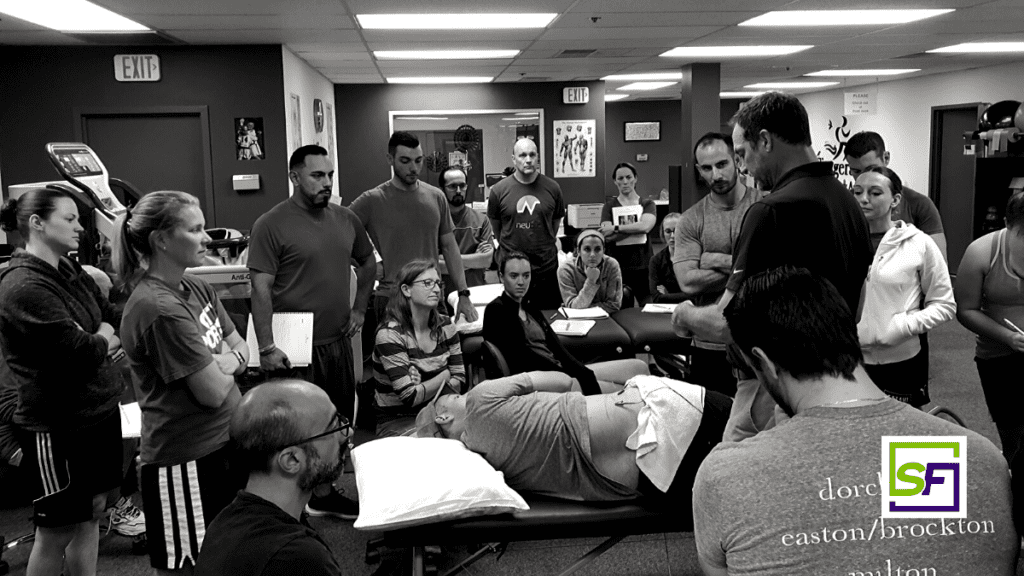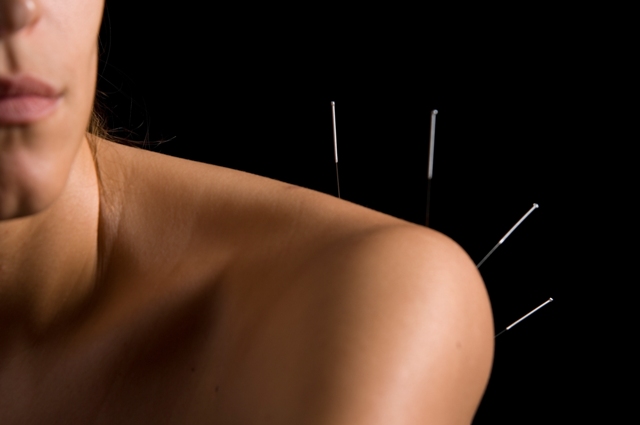Sue and I often discuss the techniques we teach and how to teach them in the safest yet effective manner. There are some recent studies that I want to review for you and also discuss what they mean for dry needling safety.
Safety: Spinal Needling
A recent article was written by Mansfield and colleagues1 that was very interesting and demonstrated some real interesting evidence surrounding needling around the spine and kidney. They used 8 cadavers, found the L1 spinous process confirmed it using diagnostic ultrasound. A digital caliper was then used to measure laterally to the right from the L1 spinous process and a surgical marker was used to mark 1.5 cm (.6 in), 2.0 cm (.78in), and 2.5 cm (.98 in) laterally. Acupuncture needles (0.25 x 75 mm) were then inserted perpendicularly and inserted maximally until the needle could not advance further. The 75 mm needles were used to gain a better idea of the depth of penetration possible since the primary aim was to determine the depth of the needle in areas where the needle may or may not contact the boney safety block of the spine.
The results were quite interesting and provide us a rationale for some of the safety concerns we discuss in our courses. Four of nine (44.44%) of 75 mm needles did not make bony contact at 2.5 cm lateral compared to 22.2% at 1.5 cm and 2.0 cm lateral. This demonstrates the distance lateral to the spinous process matters for safety. Interestingly, for two cadavers, the researchers were able to insert a 75 mm needle to its full depth at 1.5 cm without making bony contact. One of these cadavers had a large torso (35.5 cm) which could explain why the needle didn’t bottom out. However, the most interesting finding was in a cadaver that had scoliosis with a left thoracic curve and increased concavity on the right aspect of the spine. The cadaver with scoliosis had an abdominal caliper reading of 25.8 cm, so was not large. Bony contact was not made at any needle position on this subject (1.5 cm, 2.0 cm, 2.5 cm). This brings us to our discussion of the safety of dry needling patients with atypical anatomy. Scoliosis is a real concern for dry needling safety. The changes in the anatomy removed the boney safety block on this cadaver, with a 3-inch needle! This should give us all pause relative to needling around the spine when scoliosis is present. We discuss this concern in our foundations and advanced courses. There are times it is not prudent to dry needle, and this evidence provides credence to scoliosis being one of those times.
Safety: Thoracic Needling
Another interesting study published by Mitchell and colleagues2 recently focused on the safety of needling in the thorax. They used a sample of convenience of 60 subjects, 20 subjects in each of the three BMI groups (BMI 18.5 to 24.9; normal weight, BMI 25 to 29.9; overweight, and BMI of 30 or greater; obese). The subjects were placed in 2 prone positions on a treatment table with the head slightly lowered and the arms positioned along the trunk. The two prone positions varied only by the placement of the bolster under the shoulder, the diameter of the bolster was 7 cm but was increased its size for larger subjects by an average of 2 cm to retract their scapula. Diagnostic ultrasound was used to determine the depth of tissues around the thorax. They measured the distance from skin to lung tissue and muscle thickness at three sites, in this order: (1) the upper trapezius/levator scapulae, (2) rhomboid minor and (3) rhomboid major levels.
Results demonstrated that a bolster placed under the shoulder significantly increased the distance between skin and pleura on average by 0.7 cm (.25 in). Specifically, the measurements were taken at the sites of upper trapezius/levator scapulae, rhomboid minor and rhomboid major increased by 0.7, 0.7 and 0.6 cm respectively. This article shed’s some light on the differences positioning can have on the depth of lung tissue and ribs. It also demonstrates how scapular positioning can aid in providing greater distance to the lung tissue through the use of a bolster to retract and wing the scapula. This reflects similar evidence from Chu et al.3 that studied prone positioning vs seated positioning in tissue depth of the trapezius. Their evidence demonstrated greater distance to the plural tissues in a prone position rather than seated. Proper positioning when performing dry needling around the thorax is imperative to provide maximally safe conditions for the technique. This is why many of our advanced techniques use positioning that maximizes safety as described by McCutcheon and collegues4. As such, practitioners should not deviate from the patient position, needle length and lift technique they are taught in Structure & Function Education courses to maximally decrease the chances of a pneumothorax.
Safety: Broken Needle
The last article to discuss relative to safety centers on the need to not bury our needles to the handle. In a recent article by Snyder5, he details a case of a patient who suffered the adverse event of a broken needle. The patient received acupuncture for neck pain. During the treatment, one of the acupuncture needles fractured in the patient’s neck in the right paraspinal region, near the C1-C2 junction. The acupuncturist immediately attempted to retrieve the needle with a pair of tweezers, but his attempt failed as the needle was too deep to retrieve.
Following the failed retrieval attempt, the acupuncturist immediately sent the patient to the hospital to have a radiograph performed. Upon viewing the radiograph, it was discovered that two needles had fractured in the patient’s neck. The known needle was discovered near the C1-C2 junction, while a previously unknown second needle was discovered abutting the left facet of the C6-C7 segment. The patient reported that he believed that the second needle had fractured during a treatment that he had received four days prior The images revealed that neither of the needles posed an immediate threat to the patient, at which time he was discharged for his flight home to the United States, where he would have the needles removed. Following his flight, the patient presented to an American hospital where it was discovered that the needle fragments had migrated during the flight, with one needle now located 2 mm from the patient’s vertebral artery. Surgical intervention was required to retrieve the needles.
The author recommended that when inserting the needles, clinicians may consider leaving more than just the needle handle exposed above the skin so that if the needle breaks where the needle and shaft come together, part of the needle will remain exposed for retrieval.
They also recommended clinicians should also ‘count in’ and ‘count out’ the needles used during a dry needling session to assure that all needles are accounted for and that no needles unknowingly remain in the patient’s body. These are two practices we discuss in our courses. The need for assuring that some of the needle shaft, approximately a quarter of the needle length should be left and available in the case where a needle may break. This case also demonstrates the need for immediate removal of broken needles, so they do not migrate toward potentially harmful structures.
These recent studies provide us with safety concerns and verify the need for proper practices when dry needling safely. To learn more about safe dry needling techniques, sign-up for a course at www.structureandfunction.net.
Stay safe,
Brian Hortz, PhD, AT, SFDN
Director of Research and Education – Structure & Function Education
References:
- Mansfield, Cj, M Harr, M Briggs, J Onate, and Lc Boucher. “Safety of Dry Needling to the Upper Lumbar Spine: A Pilot Cadaver Study.” Journal of Manual & Manipulative Therapy, December 25, 2019, 1–8. https://doi.org/10.1080/10669817.2019.1708593.
- Mitchell, Ulrike H., A. Wayne Johnson, Robert E. Larson, and Cameron T. Seamons. “Positional Changes in Distance to the Pleura and in Muscle Thickness for Dry Needling.” Physiotherapy 105, no. 3 (September 2019): 362–69. https://doi.org/10.1016/j.physio.2018.08.002.
- Chu, Hongmin, Jaehyun Kim, Wonbae Ha, Eunbyul Cho, Geon Kang, Seongjun Park, Jongwon Jang, et al. “Change of Safe Needling Depth at Acupoint GB21 According to Posture and Breathing.” Evidence-Based Complementary and Alternative Medicine 2018 (2018): 1–9. https://doi.org/10.1155/2018/2308102.
- McCutcheon, Leigh, and Michael Yelland. “Iatrogenic Pneumothorax: Safety Concerns When Using Acupuncture or Dry Needling in the Thoracic Region.” Physical Therapy Reviews 16, no. 2 (April 2011): 126–32. https://doi.org/10.1179/1743288X11Y.0000000012.
- Snyder, Drew D. “Acupuncture Gone Awry: A Case Report of a Patient Who Required Surgical Removal of Two Single-Use Filament Needles Following Acupuncture Treatment.” Journal of Manual & Manipulative Therapy, April 25, 2019, 1–5. https://doi.org/10.1080/10669817.2019.1608010.




